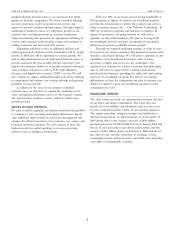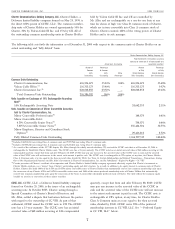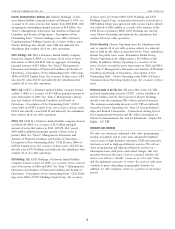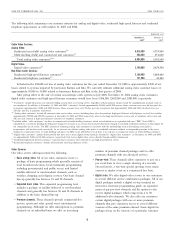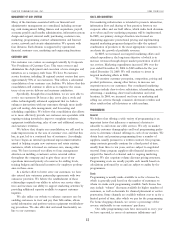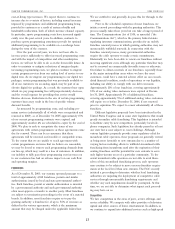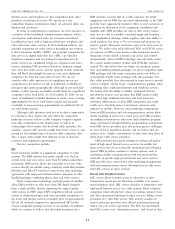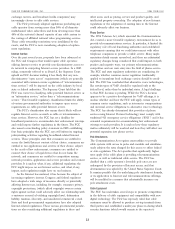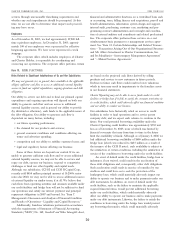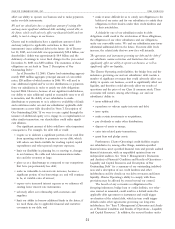Charter 2005 Annual Report Download - page 21
Download and view the complete annual report
Please find page 21 of the 2005 Charter annual report below. You can navigate through the pages in the report by either clicking on the pages listed below, or by using the keyword search tool below to find specific information within the annual report.
CHARTER COMMUNICATIONS, INC. 2005 FORM 10-K
Although our cable service offerings vary across the markets we serve because of various factors including competition and
regulatory factors, our services, when offered on a stand-alone basis, are typically offered at monthly price ranges, excluding franchise
fees and other taxes, as follows:
Price Range as of
Service December 31, 2005
Analog video packages $ 6.75 — $ 58.00
Premium channels $10.00 — $ 15.00
Pay-per-view events $ 2.99 — $179.00
Digital video packages (including high-speed Internet service for higher tiers) $34.00 — $114.98
High-speed Internet service $21.95 — $ 59.99
Video on demand (per selection) $ 0.99 — $ 29.99
High definition television $ 3.99 — $ 9.99
Digital video recorder (DVR) $ 6.99 — $ 14.99
In addition, from time to time we offer free service or We adopted the hybrid fiber coaxial cable (‘‘HFC’’)
reduced-price service during promotional periods in order to architecture as the standard for our systems upgrades. HFC
attract new customers. There is no assurance that these architecture combines the use of fiber optic cable with coaxial
customers will remain as customers when the period of free cable. Fiber optic cable is a communication medium that uses
service expires. glass fibers to transmit signals over long distances with
minimum signal loss or distortion. Fiber optic cable has
OUR NETWORK TECHNOLOGY excellent broadband frequency characteristics, noise immunity
and physical durability and can carry hundreds of video, data
The following table sets forth the technological capacity of our and voice channels over extended distances. Coaxial cable is less
systems as of December 31, 2005 based on a percentage of expensive but requires a more extensive signal amplification in
homes passed: order to obtain the desired transmission levels for delivering
channels. In most systems, we deliver our signals via fiber optic
Less than Two-way cable from the headend to a group of nodes, and use coaxial
550 megahertz 550 megahertz 750 megahertz 860/870 megahertz enabled
cable to deliver the signal from individual nodes to the homes
8% 5% 40% 47% 87% passed served by that node. Our system design enables a
Approximately 92% of our homes passed are served by maximum of 500 homes passed to be served by a single node.
systems that have bandwidth of 550 megahertz or greater. This Currently, our average node serves approximately 385 homes
bandwidth capacity enables us to offer digital television, high- passed. Our system design provides for six strands of fiber to
speed Internet services and other advanced services. It also each node, with two strands activated and four strands reserved
enables us to offer up to 82 analog channels, and even more for spares and future services. We believe that this hybrid
channels when our bandwidth is used for digital signal network design provides high capacity and superior signal
transmissions. Our increased bandwidth also permits two-way quality. The design also provides reserve capacity for the
communication for Internet access, interactive services, and addition of future services.
telephone services. The primary advantages of HFC architecture over tradi-
We have reduced the number of headends that serve our tional coaxial-only cable networks include:
customers from 1,138 at January 1, 2001 to 720 at December 31, (increased bandwidth capacity, for more channels and other
2005. Because headends are the control centers of a cable services;
system, where incoming signals are amplified, converted,
processed and combined for transmission to the customer, (dedicated bandwidth for two-way services, which avoids
reducing the number of headends reduces related equipment, reverse signal interference problems that can occur with
service personnel and maintenance expenditures. We believe two-way communication capability; and
that the headend consolidation, together with our other (improved picture quality and service reliability.
upgrades, allows us to provide enhanced picture quality and
We currently maintain a national network operations center
greater system reliability. As of December 31, 2005, approxi-
to monitor our data networks and to further our strategy of
mately 86% of our customers were served by headends serving
providing high quality service. Centralized monitoring is increas-
at least 10,000 customers.
ingly important as we increase the number of high-speed
As of December 31, 2005, our cable systems consisted of
Internet customers utilizing two-way high-speed Internet service.
approximately 222,100 strand miles, including approximately
Our local dispatch centers focus primarily on monitoring the
58,200 strand miles of fiber optic cable, passing approximately
HFC plant.
12.5 million households and served approximately 6.2 million
customers.
11




